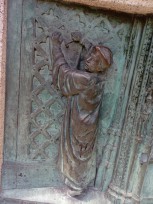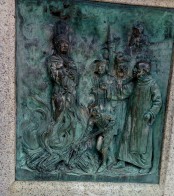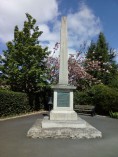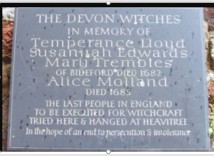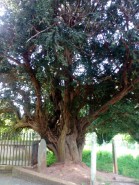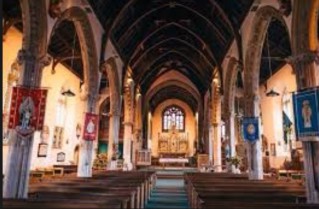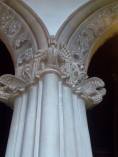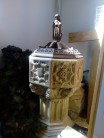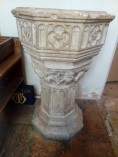
On Wednesday, 9 May, 35 of us congregated to visit two churches, one chapel, General Gordon's memorial and the one-time hanging grounds of Livery Dole.
We started our Heavitree tour with the Church of the Blessed Sacrament, built in 1931, which displays six green marble columns. Inside there is much marble saved from remodelling of Marley House on Woodbury Common. In the sanctuary are seven Italian Cippolino marble pillars around the green onyx altar.
The church was built in 1931/32. It had a much taller tower but sadly, during the war, a bomb fell at an angle knocking the top half of the tower sideways and flattening the vicarage. Fortunately, the vicar was in the church at the time so survived. The church bell also survived. Many beautiful stained glass windows were destroyed and some have been replaced with clear glass which cast long beams of light down through the nave towards the altar, so actually provide a better effect.
The altar is, unusually, at the west end of the building (i.e. not pointing towards Jerusalem) and outside, the altar area projects beyond the main block in a half circle, with a green leaded roof. Inside the half-circle are the green onyx altar surrounded by 7 pillars (5 are a pale grey and 2 much darker), from Manley House. These days the priest stands behind the altar facing the congregation.
Two white marble statues adorn the rear walls, one of St Peter and one of Mary & Jesus, below new stained glass windows which replace those also lost from the bombing. When the sun shines, these windows cast a carpet of light on the floor below. A martyr from Pinhoe who fell out with King Henry is also remembered and the Stations of the Cross on the walls are most attractive 3-dimensional wooden statues.
The church's bell, recently restored, rings in “A flat”, specifically to match and harmonise with the bells of St Michael's.
From there we moved to Livery Dole which was used as a place of execution for murder, witchcraft, heresy or treason. The name probably derives from the Old English Leofhere, a man who owned the land, and dole, meaning a piece of land and is first recorded in a document of 1279. Then, in 1452, there is a record that Henry VI met clergymen there to be escorted to the Cathedral.
Benet was burnt at the stake, just inside what is now the entrance to the gardens on Livery Dole. His crime was that he nailed a notice to a door of Exeter Cathedral proclaiming (1) that the pope was an Anti-Christ and (2) rejecting the pope’s supremacy in religious affairs. He refused to recant and so angered “the common people” that right here on Livery Dole and before the fire was even lit one John Barnehouse ‘took a furze-bush upon a pike, and having set it on fire, thrust it unto his face, saying, "Ah! whoreson heretic! pray or I will make thee do it".’ Then the fire was lit. That was when Henry VIII was on the throne.
Agnes Prest in 1557 was burnt at the stake in Southernhay for heresy. She rejected the church’s teachings so her Catholic husband reported her to the authorities. But she seems to have been treated not unkindly until she totally blotted her copy book by declaring to a stonemason mending statues at Exeter Cathedral "What a madman art thou, to make them new noses, which within a few days shall all lose their heads". That was during the reign of Mary, Henry's daughter.
In 1909 a monument commemorating the martyrdom of Thomas Benet and Agnes Prest was erected in nearby Denmark Road - well worth a visit but a little too far away to visit today. This monument, an obelisk of Dartmoor granite, was designed by Harry Hems and paid for by public subscription. The sides of the monument show poor old Agnes on fire and Thomas Benet nailing his document to the door (photos above).
The 'Devon witches' - four women from North Devon - were tried at the castle and hanged at Heavitree in 1682. They seem to have been accused of causing illness in other women and consorting with birds. Obviously that proved they were witches..…! Interestingly, the commemorative plaque by the castle gatehouse (left) was put up and is maintained by an American relative of Alice Molland.
Until 1531, heretics were burnt at the stake but from then until 1818 hangings were performed on a site known as "Magdalen Drop". This is now the carpark to the left of the entrance to the Peninsula Medical School in Magdalen Road.
Other horrible happenings are that:
In 1815 one William Vincent was convicted of the murder of a customs officer. He managed to cut his own throat in prison, but was roughly stitched up, taken to the gallows on his bed, and hanged.
One Samuel Holmyard was found guilty of printing forged banknotes and hung here on 13 Nov 1818.
Chapel and almshouses
The Chapel was built originally between 1418 and 1439 for people to pray for the souls of persons executed on Livery Dole. The present building, made from red Heavitree stone, dates from the re-building in 1592 by Sir Robert Dennis. He stated in his will that he had "designed to set aside a plot of ground and to erect an alms-house and chapel for a certain number of poor people with weekly stipends” . His son, Sir Thomas Dennis, completed the work in 1594. A "peppercorn" chief rent of one penny per annum was payable by the Livery Dole Hospital to the lord of the manor of Heavitree.
Louisa, Lady Rolle, an heir of the Dennis family, rebuilt the western end of the almshouses in 1849. The escutcheon on the gable of the central entrance bay shows the arms of Rolle impaling Trefusis. The original almshouses stood at the south-west side of the chapel, but the new buildings were positioned north-west of the chapel, which allowed space for lawns and gardens in front of them.
General Gordon Memorial
There used to be a toll house at the apex of the Livery Dole triangle until they were all closed when the Local Government Act of 1888 transferred responsibilities for road maintenance to local councils.
The land was then used for a memorial lamp post bearing the inscription: "Charles George Gordon, 26th January 1885" erected in memory of General Gordon who was killed in the Siege of Khartoum. It was paid for by the local vicar, a friend of the General's - we learnt later that Gordon had actually stayed with the vicar in the presbytery.
Gordon had been employed by the Egyptian government and had made great (though unsuccessful) efforts to suppress slavery. There was so much money in the business that no one – including members of the Egyptian government – was interested in its demise. He had left Egypt exhausted but returned at the bequest of our government under a unclear directive – some thought he was to advise our authorities on the state of Egypt but he believed he was there to “administer”.
The long exploitation of the Sudan by Egypt had led many Sudanese to rally to the Mahdi's Black Banner. His plan was to establish an Islamic fundamentalist state marking a return to what he termed "pure Islam". He besieged Khartoum.
Gordon’s mandate was to report on the situation and advise on the best way to evacuate Khartoum. He was forbidden to go there, so he went. He did organise the evacuation of 2,500 women, children, sick and wounded, but was determined to stay and defend the city.
As we know, he failed. His severed head was stuck in a tree for all to revile and his body chucked down a well. The city was ransacked and 7,000 were slaughtered. The so-called relief force, which famously arrived two days too late, consisted of only 2 steam boats and 20 soldiers and they scarpered pretty quickly! One wonders why it was ever considered to be a relief force.
What Gordon didn’t know was that Britain had decided that defending the Sudan was not worth the huge financial costs. Soon the British presence was withdrawn.
Gordon, however, went down in history as a brave man – which he certainly was. After their victory in Khartoum, the Mahdi imposed a rule so harsh that it caused the estimated deaths of 8 million people.
St Michael and All Angels
We then visited this delightful Victorian church, seemingly far too big for the small village of Heavitree, as it then was. Outside was the yew tree believed to be very many centuries old and dating from the days when the word 'heavy' also meant large. Many believe that Saxon chiefs would sit under this tree and dispense justice to those who pleaded their cause to him.
From this we turned our attention to the church, first mentioned in records of 1156. The first church was wooden and replaced with a stone building in medieval times. It was then completely rebuilt and enlarged in Victorian times and the present set of eight bells was installed in 1846 to celebrate Queen Victoria's jubilee. The church could be seen from a great distance, towering above the little hamlet of Heavitree.
When Gilbert Scott was employed to update Exeter Cathedral he discarded a number of carvings and these landed up here in St Michaels, These included "Jesus with his 11 disciples at the last supper" (Judas being excluded!). Gilbert Scott also at that time produced a magnificent reredos for a chapel in the Cathedral. But in later times the Cathedral turned its back on Victoriana and wanted to rid themselves of, amongst other treasurers, Gilbert Scott's reredos. That was their loss and St Michael's gain.
